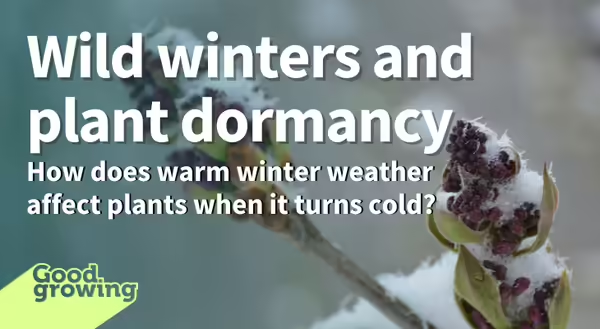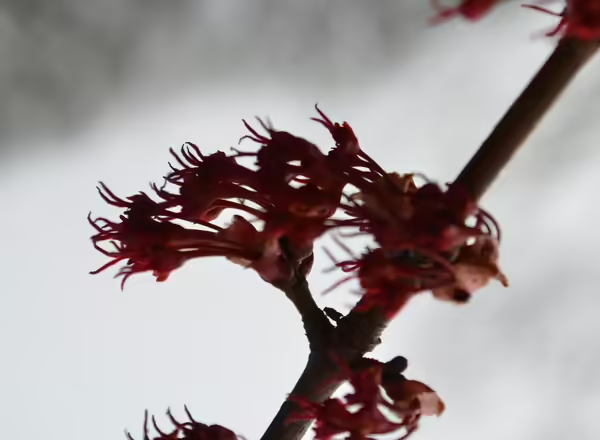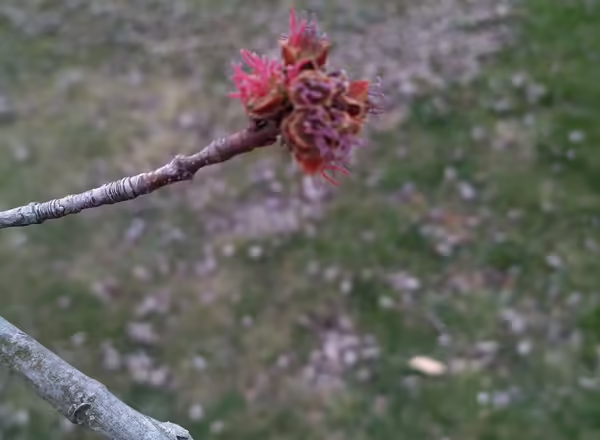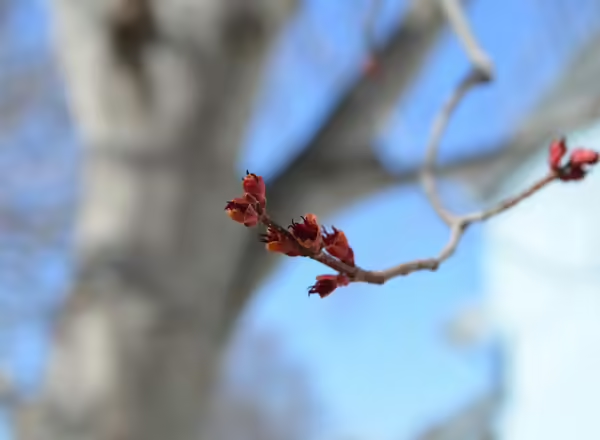
So far, the month of February 2024 has been mild. As I write it is currently 75 degrees Fahrenheit (F) outside and I am using all my willpower to stay inside and type out this article. In addition to fighting the urge to clean up the garden, some people have been concerned about how the warm winter weather will impact their garden and landscape plants.
Will the warm weather bring our plants out of dormancy? This answer is complicated and could fill a textbook. To keep things simple, let’s focus on deciduous trees and shrubs.
What influences dormancy?
Dormancy in plants is driven by two factors: day length and temperature. While day-to-day temperatures can be inconsistent, the consistent changes in shortening day length are what send plants into dormancy in the fall. Once in a deep winter slumber, it is a combination of day length and temperature that will break a tree or shrub’s dormancy. Again, to narrow our focus for this article, we’re going to look specifically at the influence of temperature.
Life in Central Illinois is accustomed to swings in winter temperatures, but 70-plus degrees for several days during February is rare indeed. Fortunately, many of our native plants are accustomed to long winters and aren’t tricked out of dormancy so easily.
Mother Nature has been at this game for a long time. Over the eons, plants have encountered warm winter weather, triggering growth, which is killed off when the freezing temperatures return. According to University of Minnesota Extension, to counter the issue of plant tissue being killed by late winter freezes, many of our woody plants developed a threshold where temperatures need to remain above 24 to 50 degrees F for up to four to eight weeks before breaking dormancy.
Our northern species such as swamp white oak (Quercus bicolor), are unhurried to break dormancy and are slower to leaf out in the spring. However, if you are growing plants that are common in the Southern US (or the far North where spring is short), then you may see some come out of dormancy earlier than usual.
A great example of this is a peach tree. Peaches are adapted to growing in southern parts of Illinois, but once you reach Central Illinois the late spring freezes play havoc with this species that really wants to wake up sooner than it should. This leads to inconsistent fruit bearing as sporadic spring frosts kill the peach flowers.
Even with nature’s dormancy safeguards, we have been experiencing a very mild February, and despite a few dips into the teens, the forecast is still a little warmer than usual. If lows remain above 32 degrees for a couple more weeks, even our northern species may begin to leave dormancy earlier than normal.



Freeze and drought stress
If a tree or shrub sprouts too soon and is exposed to freezing damage, that plant will likely survive. Unfortunately, the plant must recover from the freeze damage and that recovery takes a lot of energy when coming out of dormancy. How a plant performs after using up limited resources in the spring depends on the resources the plant had when it went into dormancy in the fall. Looking back to last autumn, West-Central Illinois was in a drought. This means our woody plants went into dormancy experiencing stress. Coming out of dormancy and immediately encountering both drought and freezing stress may impact the overall health of a tree. Spring 2024 is going to be interesting to see if we return to more seasonable rainfall and temperatures or if will we continue to encounter drought and other environmental stresses as we have had the past few years.
While we can’t control the weather, we can provide resources for our plants. You can irrigate plants during the winter, so long as the soil is not frozen. A layer of wood mulch or leaves can help to insulate the soil, protect plant roots, and hold moisture.
There’s a lot more to dormancy:
To say plant dormancy is a complicated topic is an understatement. There is a lot not covered in the above article such as the photoreceptor cells at branch tips that can sense the changing day length of springtime, triggering chemical responses in the woody plant for root growth which sends the plant growth hormone auxin to the branch tips that signal the buds to open.
There are also two types of dormancy:
Endo-dormancy – occurs as the trees or shrubs enter dormancy in the fall. This type of dormancy is held by internal plant inhibitors that cannot be broken even with ideal warm weather. To break endo-dormancy a woody plant must go through enough cold weather. This is known as chilling hours. More on that below.
Eco-dormancy – occurs after the plant has met its chilling requirement, but something about the growing conditions is just not conducive for sprouting (such as prolonged winter weather).
Chilling hours matter too!
Chilling requirements, often measured in hours, are a period during which the plant is exposed to cold weather (typically between 32 and 45 degrees Fahrenheit) to bring the plant out of dormancy. Not all cold temperatures are as effective when it comes to chilling hours. Michigan State University suggests that “temperatures between 40 and 50 degrees Fahrenheit are most effective. Temperatures just above freezing and above 50 F are less effective and temperatures above 60 F often have a negative effect on chilling.”
How many chilling hours has your geographic area accumulated so far this year? Check out the Midwestern Regional Climate Center and look at their Custom Chilling Hours Tool. This map allows you to pick a weather station nearest you and see how many chilling hours your area has for the winter. As of February 26, my nearest station in Burlington, IA is at 1,439 chilling hours. This site even has maps showing the departures of chilling hours from normal.
Has your trees or shrubs met their chilling requirement and shifted from endo-dormancy to eco-dormancy?
If you are tracking tree fruits and a few other perennial crops, this information is easy to find. There is a lot of research on crops like apples, peaches, blueberries, and more. A listing of chilling hour requirements for those are listed below. As for our ornamentals, as of now, I am struggling to find many references to shade trees and shrubs. For example, pecan is a large tree that can be grown from Mexico to Northern Illinois. Because this tree has economic importance, chilling hour requirements have been researched. But these range from less than 100 chilling hours up to 1,000 chilling hours. And that’s when it really boils down to plant genetics. The best recommendation I can make is to grow native plants or those well-adapted to your local climate. Buying locally propagated plant material also helps to secure local plant genetics.
Is your head spinning with all this dormancy talk? Mine is too. While we don’t know what the weather has in store for us I do know the soil where my garlic is planted is dry. I think it’s time to shut down this cruel computer and head outside to water some plants…in February!
Approximate Hours of Chilling (<45°F)
- Apple 800 to 1750
- Raspberry 800 to 1700
- Pear and sour cherry 600 to 1500
- Cherry (sweet) 500 to 1450
- Blueberry (highbush) 800 to 1250
- Peach 375 to 1200
- Apricot 300 to 1000
- Blackberry 350 to 600
- Grape 50 to 400 (adequate growth) 400 to 1650 (better and faster growth)
- Strawberry 50 to 300
Good Growing Fact of the Week: Another potential issue with plants waking up too early would be a plant blooming out of sync with a particular pollinating species. Specialized pollinators are at a greater risk. Generalist pollinators would be okay.
Bonus Good Growing Fact of the Week: Many of our native prairie plant seeds have a cold requirement known as stratification built into their genetics, where exposure to cold weather and wet soils initiates the chemical breakdown of their seed coat allowing for germination.
References
Winter dormancy and chilling in woody plants by Mark Longstroth, Michigan State University Extension - January 16, 2013
How will this warm winter affect my plants? by Julie Weisenhorn, Extension horticulture educator; Brandon Miller, assistant professor - horticulture; Jon Trappe, Extension turf educator; Marissa Schuh, Extension IPM educator, and Madeline Wimmer, Extension fruit educator, University of Minnesota Extension - February 16, 2024
Sign up for our emails! Want to get notified when new Good Growing posts are available? SIGN ME UP
Give us feedback! How helpful was this information (click one): Very helpful | Somewhat helpful | Not very helpful
MEET THE AUTHOR
Chris Enroth is a horticulture educator with University of Illinois Extension, serving Henderson, McDonough, Knox, and Warren counties since 2012. Chris provides horticulture programming with an emphasis on the home gardener, landscape maintenance personnel, and commercial landscapers. Additional responsibilities include coordinating local county Master Gardener and Master Naturalist volunteers - providing their training, continuing education, advanced training, seasonal events, and organizing community outreach programs for horticulture and conservation assistance/education. In his spare time, Chris enjoys the outdoors, lounging in the garden among the flowers (weeds to most).